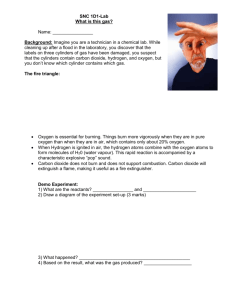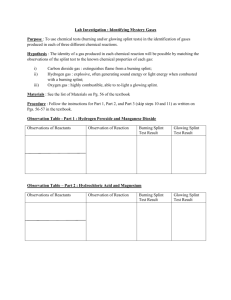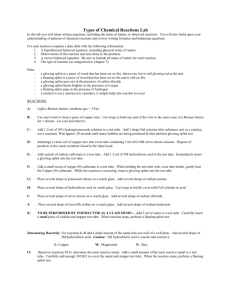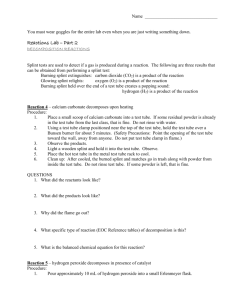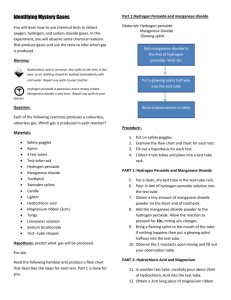Mystery Gas Identification Lab Worksheet - Chemistry
advertisement
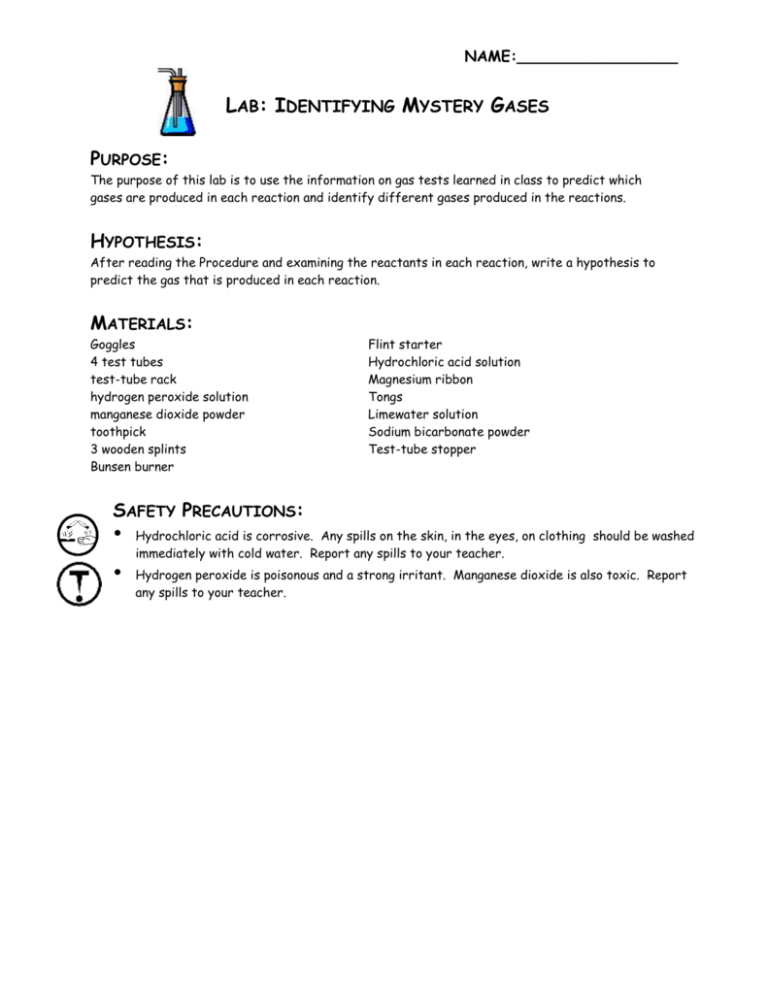
NAME:_________________ LAB: IDENTIFYING MYSTERY GASES PURPOSE: The purpose of this lab is to use the information on gas tests learned in class to predict which gases are produced in each reaction and identify different gases produced in the reactions. HYPOTHESIS: After reading the Procedure and examining the reactants in each reaction, write a hypothesis to predict the gas that is produced in each reaction. MATERIALS: Goggles 4 test tubes test-tube rack hydrogen peroxide solution manganese dioxide powder toothpick 3 wooden splints Bunsen burner Flint starter Hydrochloric acid solution Magnesium ribbon Tongs Limewater solution Sodium bicarbonate powder Test-tube stopper SAFETY PRECAUTIONS: Hydrochloric acid is corrosive. Any spills on the skin, in the eyes, on clothing should be washed immediately with cold water. Report any spills to your teacher. Hydrogen peroxide is poisonous and a strong irritant. Manganese dioxide is also toxic. Report any spills to your teacher. NAME:_________________ SNC1D1 LAB - IDENTIFYING MYSTERY GASES PROCEDURE: Part 1: Hydrogen Peroxide and Manganese Dioxide 1. Put on your goggles. 2. Using a clean, dry test tube, pour about 4 cm of hydrogen peroxide solution into a test tube. Obtain a tiny amount of manganese dioxide powder on the blunt end of a toothpick. Record 3 physical properties of the two reactants in the observation table. 3. Light a burning splint using the Bunsen burner according to the instructions given by your teacher. 4. Add the manganese hydroxide to the hydrogen peroxide. Allow the reaction to proceed for about 5 seconds, and note changes during the reaction in the observation table. 5. Bring the burning splint close to the mouth of the test tube. If no reaction occurs, blow out the flame and insert the glowing splint half way into the test tube. 6. Record your observations, and the result of the splint test in the observation table. Part 2: Hydrochloric Acid and Magnesium 1. Obtain another clean, dry test tube. Pour about 4 cm of hydrochloric acid solution into the test tube. Obtain a small piece of magnesium ribbon. Record 3 physical properties of the two reactants in the observation table. 2. Light a burning splint using the Bunsen burner according to the instructions given by your teacher. 3. Roll the magnesium into a ball and add it to the acid using forceps. Note any changes of the reaction in the observation table. 4. Bring the burning splint close to the mouth of the test tube. If no reaction occurs, blow out the flame and insert the glowing splint half way into the test tube. 5. Record your observations, and the result of the splint test in the observation table. Part 3: Hydrochloric Acid and Sodium Bicarbonate 1. Obtain two clean, dry test tubes. Pour about 4 cm of fresh limewater solution into the first test tube. Pour about 4 cm of hydrochloric acid solution into the second test tube. On a piece of paper, obtain a small amount of sodium bicarbonate. Record 3 physical properties of the two reactants in the observation table. **PLEASE NOTE: LIMEWATER IS NOT A REACTANT**. 2. Slowly add the sodium bicarbonate into the test tube containing hydrochloric acid. Note any changes of the reaction in the observation table. 3. Light a burning splint using the Bunsen burner according to the instructions given by your teacher. 4. Bring the burning splint close to the mouth of the test tube. If no reaction occurs, blow out the flame and insert the glowing splint half way into the test tube. 5. Record your observations, and the result of the splint test in the observation table. 6. If the splint went out, carefully pour the PRODUCT GAS from the reaction tube into the limewater. DO NOT POUR THE SOLUTION INTO THE LIMEWATER TUBE. 7. Put a stopper into the limewater test tube to seal it. Mix the limewater and gas by turning the tube upside down several times. 8. Dispose of all mixtures into the waste containers provided at the end of the lab benches. Clean up your workstation, put away all materials and wash your hands. NAME:_________________ DISCUSSION QUESTIONS: Answer the following questions using complete sentences. 1. Why did you record your observations before proceeding with each chemical reaction? (1 mark) 2. What gas(es) were you testing for with the burning splint? The glowing splint? (2 marks) 3. What gas were you testing for with limewater? (1 mark) 4. What other indication did you have that this gas might be present? (1 mark) 5. What evidence do you have of each change? (3 marks) 6. Which gas seemed to be the most hazardous in this activity? Why? (2 marks) 7. Fill in the following table, listing the chemical and physical properties of the gases produced in this investigation. (6 marks) Gas Hydrogen Carbon Dioxide Oxygen Physical Properties (2) Chemical Properties (2) NAME:_________________ PART 1 STARTING SUBSTANCE NAME PROPERTIES (AT Manganese Dioxide LEAST 3) OBSERVATIONS AFTER MIXING (AT LEAST 3) RESULTS OF GAS TEST (SPLINT OR LIMEWATER) Burning: Glowing: Hydrogen Peroxide 2 Magnesium Burning: Glowing: N/A Hydrochloric Acid 3 Sodium Bicarbonate Burning: Hydrochloric Acid Limewater: Glowing: GAS PRODUCED



